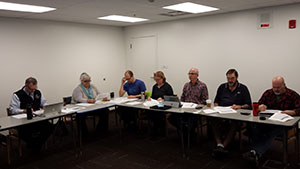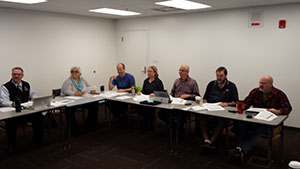— by Margie Doyle, updated Nov.14 at 2:30 p.m.—

On Nov. 7 the Orcas Island School District (OISD) board, administration and public members met to deal with the nitty-gritty decisions facing them in considering a bond proposal to complete several projects cut from previous bonds for capital construction.
First the board heard a presentation by Trevor Carlson of Piper Jaffray about scenarios for a $5,000,000 or $8,000,000 bond to finance Phase III to complete school projects that have been discussed before the community since last summer.
Chris Sutton pointed out that noting the size of school districts is helpful in comparisons because OISD is unique in high property values but low in school enrollment numbers. He also noted that it’s important to understand the district’s changing fund balance over recent years.
 Carlson, who has assisted the OISD in previous bond measures, laid the groundwork by explaining, “A bond is a debt.” Many factors go into the pricing and sales of bonds for capital construction projects such as the ones the board is contemplating. Carlson further explained the “different ways to slice and dice” a bond depending on two different ways of structuring the bond:
Carlson, who has assisted the OISD in previous bond measures, laid the groundwork by explaining, “A bond is a debt.” Many factors go into the pricing and sales of bonds for capital construction projects such as the ones the board is contemplating. Carlson further explained the “different ways to slice and dice” a bond depending on two different ways of structuring the bond:
- The first method would be as “level debt service;” the payment wouldn’t change, but the mill rate would vary over the life of the bond. In summary, a new bond for $5M would cost between 15 and 18 cents in addition to the $1.50 that is paid today
- The second method would be a level tax rate, that would be “less of a burden today . It would be “pushing interest into the future.”
Carlson projected tax rates, using today’s interest rates with projected increases, estimating. 1% growth. He also presented the details on increasing bond amounts, up to $8M.
Board members noted that in a public vote, the ballot language doesn’t specifically set millage rate or tax rates. Sutton reflected that passing a levy based on the mill rate rather than a taxable amount can have unexpected results, as when the Orcas Park and Rec District wasn’t able to collect the money they’d anticipated when “the mill rate went the other way,”
As the board turned to discuss the best amount to present to voters in February, they consulted with the Phase II Project Manager Liz LeRoy, who said that the figures presented to the board at its Oct. 27 public meeting had not changed since then. Those figures, for all elements of the previous draft of the bond proposal, totaled $14M.
OISD Superintendent Eric Webb and the board discussed two summaries of the priorities expressed by the public at several community and board meetings and surveys. The Old Gym came up high in every group’s list of priorities, as did the health and safety of the buildings: as expressed in the community meeting on Sept. 21: “taking care of what we have:” (See “Community Discuses School Bond Priorities” on Sept. 22′ 2016).
After an hour of discussion, the board identified the priorities to be included in the bond project:
- Health : High School HVAC replacement at a cost of $1,612,204
- Health: High School water improvements:, costing $964,053
- Safety: Electronic doors, costing $100,000
- Academics: New Music/Multi-purpose room at a cost of $1,358,637
- Athletics: New Track and Field remaining cost after $1M donation = $1,360,000
- Milton (Elementary) School: Interior Finish upgrades costing $500,000
- Old Gym: Exterior Improvements; Locker Rooms, Bathrooms, Equipment, Flooring at a cost of $1,428,108 High School Interior Finishes and vestibule at a cost of $500,000
- Waldron Island school: Interior, costing $47,600
- Site: School Road Improvements, costing $127,499
(All costs above include “soft” costs.)
For a total of $7, 998,002 or $8M.
The consensus was reached after much back and forth among the whole board, mostly on the viewpoints expressed by Chris Sutton and Scott Lancaster.
Sutton emphasized, “Times are much different than when we asked $35M. We’ve done a good job of handling [the $12M Phase II bond passed in 2012].
Janet Brownell advised the group, “Since August we’ve been talking $5M to $8M; we need to look at what we’re asking from the community.”
Sutton responded, “I feel that we’ve done a good job of taking it in stages and the community’s seen what we’ve done here:, we’ve built trust; built up the fund balance. It’s much different from six years ago,” when the community rejected two bond measures, for $35M and $27M.
Scott Lancaster said that the Old Gym improvements were “our original starting point; to bring a vital part of campus up to grade.
“The whole selling point of not doing it the first time was separating out the Old Gym and now we’re adding stuff to that.”
Tony Ghazel suggested as an alternative that perhaps the board should just assign a dollar amount for the track project and for the music room project, “and ask the public to raise any additional funds separately.”
Greg White argued that such a plan would “seem like we’re planning to go into the red on that.”
Sutton said that Ghazel’s idea would undercut the idea of doing a project correctly and completely.
Brownell said in reference to the track project, “There’s a fiscal responsibility when someone offers $1M dollar towards a 2M project; I feel a responsibility to make that happen.”
Later, Phase III project architect David Mount assured the group that contingency funding was built into the cost of line items that the board was debating.
Although Lancaster pointed out that the bond didn’t include increasing classroom space, it was noted that a new Music/Multipurpose room would free up the existing classroom in the Milton building.
At the meeting’s conclusion, all board members agreed they could support the $8M bond: as White expressed it, “We have something we can sink our teeth into. It’s what the community asked for and we’re being responsible”
The board plans to discuss the bond structure and to finalize the proposal at their monthly meeting, scheduled for Tuesday, Nov. 22 in observance of the Thanksgiving Day holiday.
**If you are reading theOrcasonian for free, thank your fellow islanders. If you would like to support theOrcasonian CLICK HERE to set your modestly-priced, voluntary subscription. Otherwise, no worries; we’re happy to share with you.**








It is unfortunate that the board has opted to include the track in their proposal. They lack the fundamental ability and finances to maintain this as an asset. The value of the spaces displaced by the track are used by far more individuals that the track ever will be.
The inclusion of this item in the bond proposal should result in a failure of the bond and the delay of work on the many other badly needed work.
I’d like to see the interest rate assumptions that Piper is using as a basis for their forecasts and on which the Board relied. The outlook for bond market yield curves has shifted dramatically since the November 8th election and I for one am curious as to how conservative or aggressive the assumptions are, given the length of time until the ballot.
The million dollar for the track should not be included in the
bond proposal, you should look for private donations for that
project.
I’d like to throw out a voice in support of the inclusion of the track and field complex. The offer on the table, because a generous donation, is that our community can have an athletic complex that’s worth $2.3 million for the price of $1.3 million. Or, to put it another way, we’re getting an immediate 12.5% return on our $8 million investment.
I can hear arguments that we shouldn’t pursue a donation if it’s a donation for the wrong thing. But, athletics are important to our students, as well as the community as a whole, and this is a substantial opportunity to make an appropriate investment. I applaud the School Board for including the project in the bond.